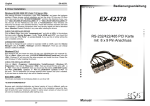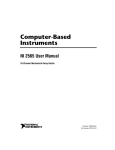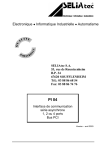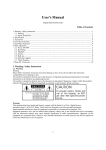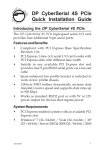Download Product Installation Guide
Transcript
MAP/950 1 PORT ISA 2, 4, 8 PORT PCI SERIAL I/O CARD INSTALLATION MANUAL HIGH-PERFORMANCE UART FAMILY This document describes the installation and use of the Axxon Computer Corporation device drivers for the 16C950 high performance UART family. Version 1.0 (16 July 2000) Installation Guide for Axxon MAP/950 ISA / PCI Bus High Performance I/O Cards V1.0 1 INTRODUCTION Thank you for choosing the Axxon line of high performance I/O cards. Please take a few moments to read through this documentation. Device drivers and utilities for the Axxon MAP/950 and ISA 16x50 with Flex-Clock products are supplied for functionality under Windows 95/98, Windows NT4 and Windows 2000. Third party support is available for the Linux OS. The ISA 16x50 with Flex-Clock product has been designed to assist in the installation of a high-speed serial port (upto 460K) WITHOUT the use of custom device drivers in virtually any OS. 2 LICENCE AGREEMENT This software and the accompanying files are provided "as is" and without warranties as to performance or merchantability or any other warranties whether express or implied. The receiver assumes all risk and liability for loss, damage, claims or expense resulting from use, possession or resale of any software and / or hardware products furnished by Axxon Computer Corporation. The receiver agrees to indemnify, defend and hold harmless Axxon Computer Corporation and its officers, agents, and employees from and against any and all claims, liability, loss, damage or expense, including reasonable attorney's fees, arising from or by reason of receivers' use, possession or resale with respect to any of the software products furnished by Axxon Computer Corporation pursuant to this agreement, and such obligation shall survive acceptance of said products therefore by receiver. Windows, Windows 95 / 98 / NT / 2000 are trademarks of Microsoft. 3 CONTENTS 1 INTRODUCTION .............................................................................................................................................................. 2 2 LICENCE AGREEMENT................................................................................................................................................. 2 3 CONTENTS ........................................................................................................................................................................ 2 4 OVERVIEW AND INSTALLATION .............................................................................................................................. 3 4.1 MAP/950 2, 4, 8 PORT PCI I/O CARD (OX16PCI954) & ISA 16X50 WITH FLEX-CLOCK ........................................... 3 4.1.1 Windows 95/98 and Windows 2000 drivers for MAP/950 PCI & 16C950 ISA I/O Cards ................................... 3 4.1.2 Windows NT4 driver for MAP/950 ..................................................................................................................... 12 4.2 ISA 16X50 PNP WITH FLEX-CLOCK (16C950 UART)................................................................................................ 13 4.2.1 Windows 95/98 and Windows 2000 drivers for standard UARTs ...................................................................... 13 4.2.2 Windows NT4 note.............................................................................................................................................. 17 5 USING THE SERIAL DRIVER ..................................................................................................................................... 18 5.1.1 5.1.2 Windows 95/98 configuration............................................................................................................................. 18 Windows 2000 configuration.............................................................................................................................. 19 6 PARALLEL PORT DRIVER IN WINDOWS 95/98 .................................................................................................... 20 7 CONTACT INFORMATION ......................................................................................................................................... 21 8 DISCLAIMER .................................................................................................................................................................. 21 Axxon Computer Corporation 2 Installation Guide for Axxon MAP/950 ISA / PCI Bus High Performance I/O Cards V1.0 4 OVERVIEW and INSTALLATION 4.1 MAP/950 2, 4, 8 Port PCI I/O Card (OX16PCI954) & ISA 16x50 with Flex-Clock 4.1.1 Windows 95/98 and Windows 2000 drivers for MAP/950 PCI & 16C950 ISA I/O Cards Overview Axxon manufactures a variety of serial port products based on the enhanced 16C950 UART. This documentation covers installation of the Single port ISA 16C950 with Flex-Clock and the MAP/950 2 (Dual), 4 (Quad) and 8 (Octo) Port PCI designs. The shipping products are FCC Class B and CE compliant. Documentation on file and available upon request. The architecture of the Windows 9x and Windows 2000 drivers is very similar. Each UART is hooked by a single-port driver, which enables the following 16C95x features: • • • • 128-byte receiver and transmitter FIFOs Adjustable receiver and transmitter interrupt trigger level with Automatic flow control Quad speed (using Times clock register) Flexible baud rate generation The drivers will automatically recognise the Axxon MAP/950 2, 4, or 8 Port PCI or ISA 16x50 with Flex-Clock in any of its default configurations. Typical Ports Environment for Axxon MAP/950 2 Port PCI Installation Com5 : DB9 ( P5 ) Com6 : DB9 ( P4 ) Axxon Computer Corporation 3 Installation Guide for Axxon MAP/950 ISA / PCI Bus High Performance I/O Cards V1.0 Typical Ports Environment for Axxon MAP/950 4 Port PCI Installation COM5 : P0, COM6 : P1, COM7 : P2, COM8 : P3 Axxon Computer Corporation 4 Installation Guide for Axxon MAP/950 ISA / PCI Bus High Performance I/O Cards V1.0 Typical Ports Environment for Axxon MAP/950 8 Port PCI Installation COM5 : P0, COM6 : P1, COM7 : P2, COM8 : P3 – Quadplex Cable attached to circuit board COM9 : P0, COM10 : P1, COM11 : P2, COM12 : P3 – Quadplex Cable attached to add-on board Timing Background The serial ports found on the IBM personal computer have historical evolved around a clock source of 1.8432 MHZ (industry standard). The Axxon MAP/950 PCI series is shipped with a 1.8432 MHZ clock source. Such a clock source permits a logical 1:1 mapping of desired baud rate to a target serial port device. Using the 16c95x UART internal clock multiplier(s) and pre-scalars in the provided device drivers, you may select upto 460K baud rate communication speed between the host PC and a serial port device (provided the target device supports upto 460K operation). The Axxon PnP 16x50 ISA Bus with Flex-Clock (pat. Pending) product is shipped with a clock source of 7.3728 MHZ. The onboard FlexClock hardware permits software configurable clock-taps of /1 (divide by 1), /2 (divide by 2), /4 (divide by 4), and /8 (divide by 8). This hardware logic is external to the onboard 16C950 UART and appears as a static clock source after programming. A DOS utility SPFLEX.EXE is provided for customisation of this Flex-Clock value. For both designs, the PCI and ISA products, select the AUTO-DETECT CRYSTAL feature in the device drivers to allow for the proper application requested baud rate to hardware baud rate relationship. Select the QUAD BAUD RATE option to activate the X4 baud rates. When active, this X4 option will map the application selected baud rate to target hardware baud rate by a ratio of X4. As an example, when this option is SELECTED, 300 Baud in the Windows application will map to and run the serial port at an actual value of 1200 Baud. Axxon Computer Corporation 5 Installation Guide for Axxon MAP/950 ISA / PCI Bus High Performance I/O Cards V1.0 Select Automatic Crystal Detection for Input Clock Automatic Crystal Detection for Input Clock This option is required to allow the device driver to correctly calculate the Input Clock being fed into the onboard UARTS. In most applications, this value will auto-detect to 1.8432 MHZ which permits a 1:1 mapping ratio relationship for Application Selected baud rate to Target Hardware baud rate. Note that the Automatic Crystal Detection will not work on port COM10 and higher. You must manually select the noted clock source of 1.8432 MHZ for the Axxon 8 Port MAP/950 PCI design on COM10, COM11 and COM12 in the Windows 9x OSes. This feature is even more important when used with the Axxon ISA 16x50 with Flex-Clock product line due to the external hardware clock divisors. In summary there exists : a) External Clock source which is fixed on the MAP/950 PCI series. Flexible HARDWARE Clock Divisors on ISA 16x50 Flex-Clock product. b) Onboard UART Clock Pre-Divisors with both designs, PCI and ISA bus products. The noted options permit most standard and non-standard user selected baud rates upto 460K via the RS232 electrical interface. Axxon Computer Corporation 6 Installation Guide for Axxon MAP/950 ISA / PCI Bus High Performance I/O Cards V1.0 Select Quad Speed for Baud Rate Generation options Quad Speed The Quad Speed option will force any host application software’s baud rate to be multiplied by a factor of 4 (Four). That is, when an application selects 115K, as an example, the actual hardware baud rate will result in a 460K communication speed with this option active. Mappings for Windows Application Selected Baud Rate to Target Hardware Baud Rate with QUAD BAUD RATE (x4) Option ON : 110 Baud (application software) maps to 440 Baud (target hardware) 300 Baud (application software) maps to 1200 Baud (target hardware) 600 Baud (application software) maps to 2400 Baud (target hardware) 1200 Baud (application software) maps to 4800 Baud (target hardware) 2400 Baud (application software) maps to 9600 Baud (target hardware) 4800 Baud (application software) maps to 19200 Baud (target hardware) 9600 Baud (application software) maps to 38400 Baud (target hardware) 19200 Baud (application software) maps to 76800 Baud (target hardware) 38400 Baud (application software) maps to 153600 Baud (target hardware) 57600 Baud (application software) maps to 230200 Baud (target hardware) 115200 Baud (application software) maps to 460800 Baud (target hardware) Axxon Computer Corporation 7 Installation Guide for Axxon MAP/950 ISA / PCI Bus High Performance I/O Cards V1.0 Select User Defined Override Speed Option to FORCE a Baud Rate User Defined Override Speed Option A quick method to FORCE a desired baud rate is to select the User Defined Override Speed Option and scroll to the proper Clock PreDivisor + Baud Rate. The above example displays this approach to FORCE a 460K baud rate speed with a Windows application. Axxon Computer Corporation 8 Installation Guide for Axxon MAP/950 ISA / PCI Bus High Performance I/O Cards V1.0 Example of User Defined Override Speed Option to FORCE 230K Baud Rate Installation Install the hardware by following system instructions. Power up the system. Then follow the instructions below depending on which operating system is installed. To upgrade the Windows 9x driver from a previous release, first boot up the system with the existing drivers. Right-click “My Computer”, select Properties, then Device Manager. Double-click “Multifunction” and remove all Oxford Semiconductor devices from this category. Restart the machine, then follow the instructions below. Windows 98 1. 2. 3. The system will detect the device and start the “Add new hardware” wizard. Click Next to continue. The system will suggest that it searches for the best driver for the device. Click Next to confirm. If the driver files are on a floppy disk, insert it into the drive now. If the driver files are on the hard disk, point the wizard at the correct directory. 4. Click Next to continue. 5. The system searches for the driver. If it doesn’t find the Axxon device driver, make sure the driver files are present and the Wizard knows where to find them. 6. Once the system has found the driver, click Next to continue. 7. The system installs the driver. 8. Click Finish. 9. If you are using the parallel port, the system detect it next. Re-iterate steps 2-8, but specify that the driver files are located in the 9x_parallel directory. 10. Once the main drivers are installed, the system installs the UART ports automatically. Axxon Computer Corporation 9 Installation Guide for Axxon MAP/950 ISA / PCI Bus High Performance I/O Cards V1.0 Windows95 (OSR21) Note: the system prompts may vary between different versions of Windows. If in doubt consult the user manual. 1. The system detects the device and starts the “Update Device Driver” wizard. 2. If you have the driver files on a floppy disk, insert it into the drive now. Click Next to continue. 3. The system searches for the driver. If it doesn’t find the Axxon device driver, click ‘Other Locations’ and enter the full path to the driver files. 4. Once the system has found the driver, click Finish. 5. The system installs the device, and then goes through the same steps for the local bus / parallel port. Note: the parallel port drivers are located in the 9x_Parallel directory. 6. Once the main drivers are installed, the system installs the UART ports automatically. (Note: due to a Win95 bug you may have to re-enter the path for it to find the files). Axxon Computer Corporation 10 Installation Guide for Axxon MAP/950 ISA / PCI Bus High Performance I/O Cards V1.0 Windows95 (original release1) Note: the system prompts may vary between different versions of Windows. If in doubt consult the user manual. 1. 2. 3. 4. The system will detect the device and ask which driver to install. Select “Driver from disk provided by hardware manufacturer”, and click OK. If you have the driver files on a floppy disk, insert it into the drive. Otherwise enter the full path to the driver files. Click OK. The system installs the device, and then goes through the same steps for the local bus / parallel port. Note: the parallel port drivers are located in the 9x_Parallel directory. Once the main drivers are installed, the system installs the UART ports automatically. (Note: due to a Win95 bug you may have to re-enter the path for it to find the files). Windows2000 1. 2. 3. 4. 5. 6. The system will detect the device and ask which driver to install. Click Next Select “Search for a suitable driver for my device”, and click Next. If you have the driver files on a floppy disk, insert it into the drive and check the “Floppy disk drives” box. Otherwise check the “Specify a location” box. Click Next If “Specify a location” was checked, you will have to enter the path to search and click OK. The system will search for a driver. When it finds it, click Next. The files will be copied and the driver installed. Click Finish. The system then installs the other logical function (parallel port / local bus) in the same manner. Once the PCI devices are installed, the system will install the UART ports automatically. Note 1: To check your version of Windows 95, right-click on “My Computer” and select “Properties”. The System Properties page will appear. If the version is 4.00.950 B or C, you are using OSR2. If the letter is A or is absent, you are running the original releases. FIFOs Selection for Axxon MAP/950 and ISA 16x50 with Flex-Clock Products Axxon Computer Corporation 11 Installation Guide for Axxon MAP/950 ISA / PCI Bus High Performance I/O Cards V1.0 4.1.2 Windows NT4 driver for MAP/950 Overview The Windows NT4 driver creates a Device Object for each port, and registers this with the operating system. The serial port driver enables the following 16C95x features: • 128-byte receiver and transmitter FIFOs • Optimized receiver interrupt handling – uses readable fill levels and thresholds • Automatic clock speed detection A separate parallel port driver is provided, which creates the device Object and registers it with the Printer class driver. Installation Install the hardware by following system instructions. Power up the system. Then follow the instructions below depending on which functions are required. To upgrade the NT4 driver, simply install over the existing version. Serial driver 1. 2. 3. 4. 5. Run “Install_Serial.exe” from the \NT4_Serial subdirectory on the disk. When the install application starts, click Next to continue Ensure ‘install’ is selected, then click Next. Click OK to accept the licence agreement. The system will install the driver and start it. The ports are immediately ready for use. Parallel driver 1. 2. 3. 4. 5. Run “Install_Parallel.exe” from the \NT4_Parallel subdirectory on the disk. When the install application starts, click Next to continue Ensure ‘install’ is selected, then click Next. Click OK to accept the licence agreement. The system will install the driver and prompt for a restart. The port is available for use after the restart. Axxon Computer Corporation 12 Installation Guide for Axxon MAP/950 ISA / PCI Bus High Performance I/O Cards 4.2 V1.0 ISA 16x50 PnP with Flex-Clock (16C950 UART) 4.2.1 Windows 95/98 and Windows 2000 drivers for standard UARTs Overview The drivers for 16C950 UART use the same port driver as the MAP/950 PCI set, therefore the same features are available: • 128-byte receiver and transmitter FIFOs • Adjustable receiver and transmitter interrupt trigger level • Automatic flow control • Quad speed (using Times clock register) SpFlex Software DOS Configuration Utility for Axxon ISA 16x50 with Flex-Clock Product SpFlex Software DOS Configuration Utility The SPFLEX.EXE configuration utility is a pure DOS application. This requires that the program be executed in a pure DOS environment only (DOS Window inside of Windows 9x and NT is not recommended). Use the SPFLEX program to define or determine the hardware clock source for the onboard 16C950 UART. In most cases, such as Windows installations, this utility is not required. In Non-PnP (Plug & Play) environments, you may use this software to manually assign the I/O Address and IRQ resources for this product. Almost all computer systems now contain a PnP ready BIOS which will automatically override the manual settings to provide a true PnP installation. An example of a non-PnP environment is an older 486, 386 or 286 CPU based computer. Axxon Computer Corporation 13 Installation Guide for Axxon MAP/950 ISA / PCI Bus High Performance I/O Cards V1.0 SpFlex Legacy I/O Address Configuration for Axxon ISA 16x50 with Flex-Clock Product in Non-Plug & Play Environments SpFlex Legacy I/O Address Configuration The I/O Address selection will be automatically checked against collisions for the ISA bus installation. In case of a potential I/O Address conflict, select another I/O Address range by using the UP / DOWN arrow keys to map this product on another 8 byte boundary. The range of mapping for this product line is 0x0100 – 0xFFF8. Please note that the LEGACY I/O Address range is overridden in a PnP (Plug & Play) environment. Axxon Computer Corporation 14 Installation Guide for Axxon MAP/950 ISA / PCI Bus High Performance I/O Cards V1.0 SpFlex Legacy IRQ Configuration for Axxon ISA 16x50 with Flex-Clock Product in Non-Plug & Play Environments SpFlex Legacy IRQ Configuration The IRQ Legacy selection must be used to manually assign a conflict free (unique) IRQ for installation on an ISA bus. This ISA product is not designed to IRQ share. Please note that the LEGACY IRQ (Interrupt) configuration is overridden in a PnP (Plug & Play) environment. Axxon Computer Corporation 15 Installation Guide for Axxon MAP/950 ISA / PCI Bus High Performance I/O Cards V1.0 SpFlex Clock Configuration for Axxon ISA 16x50 with Flex-Clock Product (PnP and Non-PnP Environments) SpFlex Clock Configuration Use this option to manually select the clock rate being fed into the 16C950 UART. The most popular selection for this option will be 1.8432 MHZ and / or 7.3728 MHZ. A 1.8432 MHZ clock source will provide for a 1:1 mapping for the baud rates with a maximum of 115K throughput in any OS environment while the 7.3728 MHZ will provide upto 460K. Selecting 7.3728 MHZ is a simple method to provide upto 460K in environments that do not have support for this enhanced UART model. Respectively, select 3.6864 MHZ to provide upto 230K. Example of 230K operation in an environment without using custom device drivers for the 16C950 UARTs a) b) c) d) Run SPFLEX.EXE in a pure DOS environment. Select Configure Port -> Change UART Clock -> Clock -> 3.6864 MHZ (ENTER to select) Select Save Settings and Exit Menu. Power Down to allow for a proper reset of this new clock source. Select 115K in the target application of your OS environment. Since the hardware UART clock source is X2 (3.6864 MHZ), your 115K software will actually be communicating at 230K. Make sure that your target hardware is capable of this communication speed. Some ISDN modems will auto-detect such a speed while others require an initialisation string to run at the noted speed. Example of 460K operation in an environment without using custom device drivers for the 16C950 UARTs e) f) g) h) Run SPFLEX.EXE in a pure DOS environment. Select Configure Port -> Change UART Clock -> Clock -> 7.3728 MHZ (ENTER to select) Select Save Settings and Exit Menu. Power Down to allow for a proper reset of this new clock source. Select 115K in the target application of your OS environment. Since the hardware UART clock source is X4 (7.3728 MHZ), your 115K software will actually be communicating at 460K. Make sure that your target hardware is capable of this communication speed. Some ISDN modems will auto-detect such a speed while others require an initialisation string to run at the noted speed. Axxon Computer Corporation 16 Installation Guide for Axxon MAP/950 ISA / PCI Bus High Performance I/O Cards V1.0 Installation Windows will identify all COM ports as standard communications ports. Once a 95x COM port is installed as a generic port, update the driver as follows: 1. Click on Start / Settings / Control Panel 2. Double click “System” to bring up the system properties dialog box 3. Select the “Device Manager” tab of this dialog (with the “View devices by type” option selected. 4. Now click on the [+] next to the “Ports (COM & LPT)” icon to show the list of installed COM ports (If this section is not present or no COM ports are listed, there are no serial devices installed in Windows. To install COM port hardware, consult your Windows / Hardware documentation.) 5. Double click on the port you want to install the new driver for to bring up the settings dialog for that port 6. Select the driver tab and click the update/change driver button. 7. Windows 95 Click on “Have Disk” and specify the location of the driver files. Click OK The files will now be copied and the driver installed. 8. Windows 98 When the “Update Device Driver Wizard” asks what you want Windows to do, select “Search for a better driver” and then click next. When asked where to select the “Specify Location” box and type the location of the driver files. Click ‘next’ and the driver will be installed. 9. Windows 2000 The system starts the Upgrade Device Driver Wizard. Click ‘Next’ Check “Search for a suitable driver for my device” and click Next. Point the wizard at the driver files (on floppy disk or fixed disk) and click Next. You may have to enter a path to the driver files. The system will find a selection of suitable drivers. Check “Install one of the other drivers” and then ‘Next’. Install the “PCI Communications Port (Comx)” The files are copied. Click finish to exit the Wizard (and restart) Alternatively, the driver can be installed manually for a new device without running the auto-detect routines. 4.2.2 Windows NT4 note There is no enhanced mode driver for standard UARTs in Windows NT4.0. This is because the generic driver will detect any ISA ports and use them itself. The maximum baud rate for the Windows NT environment (MAP/950 PCI products using the 1.8432 MHZ clock source) is 115K. Contact Axxon for details if you wish to use this product at higher baud rate. The maximum baud rate for the Windows NT environment (ISA 16x50 with Flex-Clock products using the 7.3728 MHZ clock source) is 460K. The Windows NT device driver will autodetect the enhanced features of the 16C950 UART model, number of 16C950 UART ports (1, 2, 4 or 8) and the UART clock value. Axxon Computer Corporation 17 Installation Guide for Axxon MAP/950 ISA / PCI Bus High Performance I/O Cards V1.0 5 USING THE SERIAL DRIVER The serial drivers for Windows 9x and Windows 2000 make use of a number of enhanced 95x UART features, and are highly configurable. This section describes the configuration utilities, accessible through Device Manager, which can be used to enable and configure the various features The driver will install the correct number of serial ports and Windows will assign COM numbers to them (e.g. COM5). You can then attach modems etc. to the ports and make use of them in the same fashion as any other generic port. The serial driver has extra configuration options available over and above the standard ‘settings’ tab supplied with the generic 16550 driver. To adjust any of the UART parameters, follow these steps: 1. Click on Start / Settings / Control Panel 2. Double click “System” to bring up the system properties dialog box 3. Select the “Device Manager” tab of this dialog (with the “View devices by type” option selected 4. Now click on the [+] next to the “Ports (COM & LPT)” icon to show the list of installed COM ports 5. Double click on an PCI port to display the settings dialog for that port The enhanced features are configurable through three dialog pages: Settings Data Rate FIFOs - Standard port settings found on normal COM port settings pages - Advanced data rate selection options - Device mode selection and FIFO trigger level settings 5.1.1 Windows 95/98 configuration Settings This page contains the standard Baud rate / Data bits / Parity / Stop bits and Flow control options found on most COM port settings pages. These settings modify the default settings used by Windows. Most applications that use COM ports will override these settings with their own comms parameters. Note that the baud rate selected by an application will be scaled up if a faster crystal is used This page also provides configurable RS485 half-duplex operation. RS232 applications will not use this, and the DTR pin should be configured as ‘normal’. However if RS485 line drivers are used, the driver can configure the DTR pin to enable the transmitter, in active-high or active-low form. Data Rate This page provides a list of common crystal values used with COM ports. Select “Detect crystal frequency” to detect the input clock frequency to the UART. (This requires that the port is not currently in use by another application). [Note: The “Automatic crystal selection” option will not work on COM10 and higher in Windows 9x; this is a limitation of 16-bit DLLs. For high-numbered ports the user should select the crystal frequency manually.] The quad speed option will multiply all application selected baud rates by 4 by utilising the OX16C95x Times clock register (TCR) Selecting “User Defined Override Speed” enables the fully variable baud rate slider and “Clock Pre-Divisor” list box for more flexible baud rate generation. The actual selected baud rate is displayed above the baud rate slider. The clock pre-divisor is used to divide the input clock prior to baud rate generation. This means a high speed crystal (E.g. 50MHz) can be pre-divided to generate standard baud rates (In this case 50 / 27.125 = 1.8433 MHz, which will emulate a 1.8432 MHz crystal with less than 0.01% bit rate error). Alternatively, the pre-divisor could be switched off to allow data rates up to 12.5Mbps to be generated. Axxon Computer Corporation 18 Installation Guide for Axxon MAP/950 ISA / PCI Bus High Performance I/O Cards V1.0 FIFOs This page provides three device modes. 450 mode, which forces the UART to operate in byte mode (i.e. with the FIFO disabled), 550 mode which operates with 16 byte deep FIFOs, 550 trigger levels and driver generated flow control (non-automated). Finally, 950 mode, which operates with full 128 byte FIFOs, fully adjustable trigger levels and automated flow-control. The four sliders allow adjustment of the various trigger levels in 550 and 950 modes. These are described below: • Transmitter FIFO interrupt trigger level - When the level of data in the transmit FIFO falls below this value, a transmitter interrupt is triggered. Setting this value to zero will not trigger an interrupt until the transmitter is completely idle. In 450 and 550 mode this is fixed at 1. • Receiver FIFO interrupt trigger level - When the level of data in the receiver FIFO reaches this value, a receiver data interrupt is triggered. In 450 mode this is fixed at 1, In 550 mode it can take 4 discrete values 1,4,8 & 14. • Flow On flow-control limit - When the level of data in the receiver FIFO reaches this value as data is read from the FIFO, a handshake is triggered to instruct the remote transmitter that it is free to transmit data (E.g. Transmit an XON character to the remote machine). In 450 and 550 mode this level is fixed at 1. • Flow Off flow-control limit - When the level of data in the receiver FIFO reaches this value as it fills up, a handshake is triggered to instruct the remote transmitter to stop sending data as the FIFO is becoming full. (E.g. Transmit an XOFF character to the remote machine). In 450 mode this level is fixed at 1, in 550 mode it assumes the same value as the receiver FIFO interrupt trigger level. The FIFO trigger levels can be fine-tuned to gain optimum performance, depending on system performance, baud rate used, levels of serial traffic etc. The default Receiver FIFO trigger level is preset at a value of 64; this should be increased for higher performance, but in some cases a high trigger level will result in the port not detecting PnP serial devices. 5.1.2 Windows 2000 configuration Settings This page contains the standard Baud rate / Data bits / Parity / Stop bits and Flow control options found on most COM port settings pages. These settings modify the default settings used by Windows. Most applications that use COM ports will override these settings with their own comms parameters. This page also provides configurable RS485 half-duplex operation. RS232 applications will not use this, and the DTR pin should be configured as ‘normal’. However if RS485 line drivers are used, the driver can configure the DTR pin to enable the transmitter, in active-high or active-low form. Note: if RS422/485 line drivers are selected, the driver will not allow DTR/DSR flow control, as these pins are not defined in RS422 protocols. Data Rate This page provides a list of common crystal values used with COM ports. Select “Detect crystal frequency” to detect the input clock frequency to the UART. (This requires that the port is not currently in use by another application). The baud rate can optionally be adjusted according to the data rate required. To enable the advanced baud rate configuration options, deselect the “Use default baud rate” box. In normal operation, the driver will generate the desired baud rate from the crystal frequency. The quad speed option will multiply all application selected baud rates by 4 by utilising the OX16C95x Times clock register (TCR). The driver can multiply this baud rate, or divide it using the Clock Prescaler register (CPR). The clock pre-divisor is used to divide the input clock prior to baud rate generation. This means a high speed crystal (E.g. 50MHz) can be pre-divided to generate standard baud rates (In this case 50 / 27.125 = 1.8433 MHz, which will emulate a 1.8432 MHz crystal with less than 0.01% bit rate error). Alternatively, the pre-divisor could be switched off to allow data rates up to 12.5Mbps to be generated. Axxon Computer Corporation 19 Installation Guide for Axxon MAP/950 ISA / PCI Bus High Performance I/O Cards V1.0 FIFOs This page is used to configure the FIFO trigger levels, i.e. at what fill levels the device will generate an interrupt, or apply automatic flow control. In addition, the FIFOs can be completely disabled; although this is not recommended for normal operation. The four sliders allow adjustment of the various trigger levels in 550 and 950 modes. These are described below: • Transmitter FIFO interrupt trigger level - When the level of data in the transmit FIFO falls below this value, a transmitter interrupt is triggered. Setting this value to zero will not trigger an interrupt until the transmitter is completely idle. • Receiver FIFO interrupt trigger level - When the level of data in the receiver FIFO reaches this value, a receiver data interrupt is triggered. • Flow On flow-control limit - When the level of data in the receiver FIFO reaches this value as data is read from the FIFO, a handshake is triggered to instruct the remote transmitter that it is free to transmit data (E.g. Transmit an XON character to the remote machine). • Flow Off flow-control limit - When the level of data in the receiver FIFO reaches this value as it fills up, a handshake is triggered to instruct the remote transmitter to stop sending data as the FIFO is becoming full. (E.g. Transmit an XOFF character to the remote machine). The FIFO trigger levels can be fine-tuned to gain optimum performance, depending on system performance, baud rate used, levels of serial traffic etc. 6 Parallel port driver in Windows 95/98 The parallel port driver will set the hardware to use legacy addresses 378h if available, otherwise it will be forced to use the address allocated by the system BIOS. Windows will allocate an LPT number (e.g. LPT2) to the port; then it can be used in the same fashion as any generic parallel port. Note: some peripheral devices such as ZIP drives will not operate correctly if the parallel port is not located at address 278 or 378. In this case, the conflicting devices such as the motherboard port will need to be moved to other addresses. Configuration The parallel port interrupt can be enabled / disabled using the configuration applet found in Device Manager. This may be necessary if using Windows 98 and Direct Cable connection. To adjust the setting, follow these steps: 1. Click on Start / Settings / Control Panel 2. Double click “System” to bring up the system properties dialog box 3. Select the “Device Manager” tab of this dialog (with the “View devices by type” option selected) 4. Now click on the [+] next to the “Multifunction Devices” icon to show the list of Oxford Semiconductor parts 5. Double click on the Oxford Semiconductor PCI Parallel port to display the settings dialog for that port 6. Click the “settings” tab of this dialog, and enable / disable the interrupt as required It is also possible for the port to use address 278h/678h. However, many systems do not support this option due to a contention with ISAPNP bus enumeration. Check this option to enable it; however be prepared to change it back if the port ceases to work. Axxon Computer Corporation 20 Installation Guide for Axxon MAP/950 ISA / PCI Bus High Performance I/O Cards V1.0 7 CONTACT INFORMATION For further information please contact: Axxon Computer Corporation 3979 Tecumseh Road East Windsor, Ontario Canada N8W 1J5 Telephone: Sales / Tech Support Phone: Fax: Sales / Tech e-mail: Web site: (519) 974-0163 (Main) 1-800-361-1913 (US / Canada) or Internationally via Internet Phones (519) 974-0165 [email protected] http://www.softio.com 8 DISCLAIMER Oxford Semiconductor believes the information contained in this document to be accurate and reliable. However, it is subject to change without notice. No responsibility is assumed by Oxford Semiconductor for its use, nor for infringement of patents or other rights of third parties. No part of this publication may be reproduced, or transmitted in any form or by any means without the prior consent of Oxford Semiconductor Ltd. Oxford Semiconductor’s terms and conditions of sale apply at all times. Axxon Computer Corporation 21
























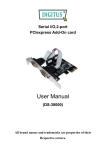


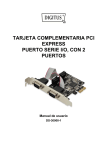

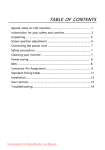

![Independence IDX 4000 IG User Manual [excerpts].](http://vs1.manualzilla.com/store/data/005651088_1-0e858df88d62387a8afea47c031c0cce-150x150.png)


